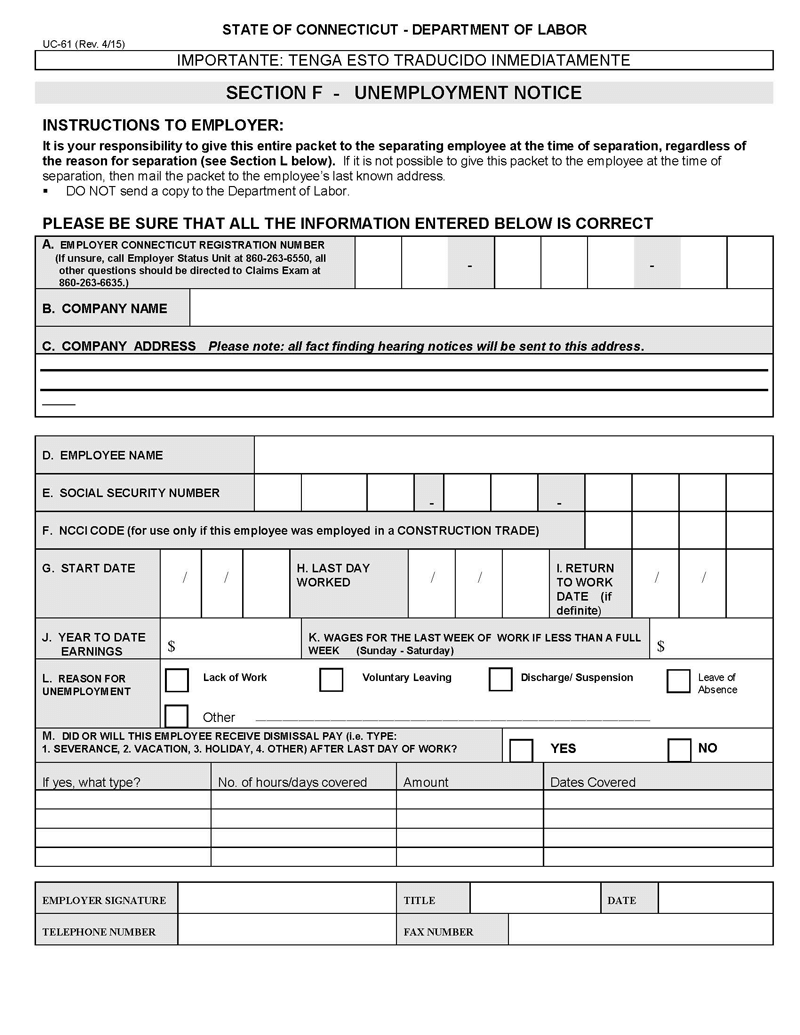The Connecticut unemployment file is a document maintained by the State of Connecticut Department of Labor that lists individuals who have applied for unemployment insurance benefits. This file determines eligibility for unemployment benefits and the benefit amounts.
The purpose of the ‘File’ is to provide a single source of information for employers and others who may need to verify an individual’s employment history. The Connecticut Department of Labor maintains the file, which is available to employers and authorized users. For an employer to have their employee’s data in this file, they must provide a Separation Packet, which has a Separation Notice —Form UC-61.
This article will cover everything employees and employers need to know about the Connecticut Unemployment Notice Form UC-61 and how to fill it.
Connecticut Unemployment File Form UC-61
The UC-61 form is the notice of unemployment employees in Connecticut receive when they are let go from their jobs. This form must include detailed information about the impacted workers, such as the expected timeframe for the layoff, the reason for the layoff, the employee’s name, social security number, and year-to-date earnings. In addition, the information required to file for unemployment benefits and how to contact the Connecticut Department of Labor is included in the UC-61 form.
The Connecticut Department of Labor mandates all employers to provide UC-61 to their employees upon termination of employment or indefinite layoff. Irrespective of the condition surrounding the employee’s termination, whether voluntary or involuntary, the employer must provide the notice form to the employee. Therefore, all information on the form must be accurate and up to date, as any inaccuracies could delay or prevent the former employee from receiving unemployment benefits.
Once the form is filed, the UC-61 Unemployment Notice Form will be used by the Department of Labor to help determine whether workers are eligible for unemployment benefits. The following section will provide a step-by-step guide on how to fill out a form UC-61.
How to Fill a Form UC-61
While the form may seem challenging to fill at first, it is relatively simple to complete. The first move is to gather all the information required on the form UC-61.
Follow the step-by-step guide below to fill out the form UC-61:
- Fill in your official contact details and personal identification details.
- To indicate the option, pick whatever is necessary and use a checkmark.
- Go over all the details you entered to ensure no error. This includes ensuring your social security number is entered correctly, as well as your contact information and work history. If you have recently moved, be sure to update your address.
- Once you have completed all the required information, select the Sign Tool to create and sign the document electronically where you see ‘Employer Signature’.
- To submit it for processing, press done.
- You can print, share or save for personal copy.
Consequences of Not Submitting Form UC-61 on Time or Incorrectly Completing it
The Connecticut unemployment notice form, UC-61, is an important document required by the state’s Department of Labor. Failing to submit the notification form on time, or incorrectly completing it, can result in several consequences, which are:
- The State of Connecticut Department of Labor must receive and process the notice form before the claimant can qualify for any unemployment benefit.
- The claimant will refund any benefit received by the claimant before an offense gets discovered.
- Claimants who do not submit the UC-61 on time may also face penalties, such as a loss of eligibility for future benefits or a reduction in the amount received.
- The claimant’s name may be added to a list of those who have failed to comply with the state’s unemployment laws, making it difficult to find future employment.
- There will be civil or criminal penalties for employers who fail to provide an accurate record.
- State of Connecticut Department of Labor may charge an employer’s account for any unemployment benefits paid to the affected employee due to a late or inaccurate report.
Common Mistakes to Avoid
When completing form UC-61, inevitable mistakes can be made. By knowing what these mistakes are, it is easier to avoid them.
These mistakes are listed below:
- Mailing the UC-61 to the wrong address
- There is a misconception among employees who quit their job voluntarily. Many think they do not have to fill out the notice form; however, this is not the case. Even if they did, they still need to complete UC-61 and submit it to the unemployment office. This has resulted in delays in receiving or even denial of benefits altogether.
- Failure to provide correct contact information such as active phone number and email address. This is how the Department of Revenue Services will communicate with claimants about their claim status.
- Listing the wrong dates for the start and end of employment. This can lead to disqualification from benefits.
- Lastly, claimants should be sure to sign and date their UC-61 form before submitting it. This may seem minor but omitting a signature can result in a claim being denied.
Conclusion
Filling out the Connecticut unemployment notice form UC-61 is simple but detailed. Precision is important. The information should be included if a specific event led to the termination of employment or indefinite layoff. The department will then review the form and determine whether or not the employee is eligible for unemployment benefits.
The Connecticut unemployment file is essential for employees who have lost their jobs. It provides a way for them to receive financial assistance while they search for new employment. The file also allows employers to see if an applicant has been recently unemployed, which can help make hiring decisions. As a result, the Connecticut unemployment file is an invaluable resource.
